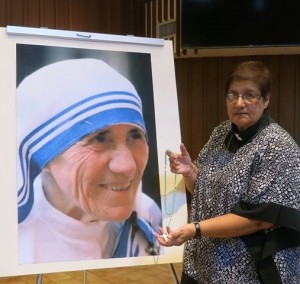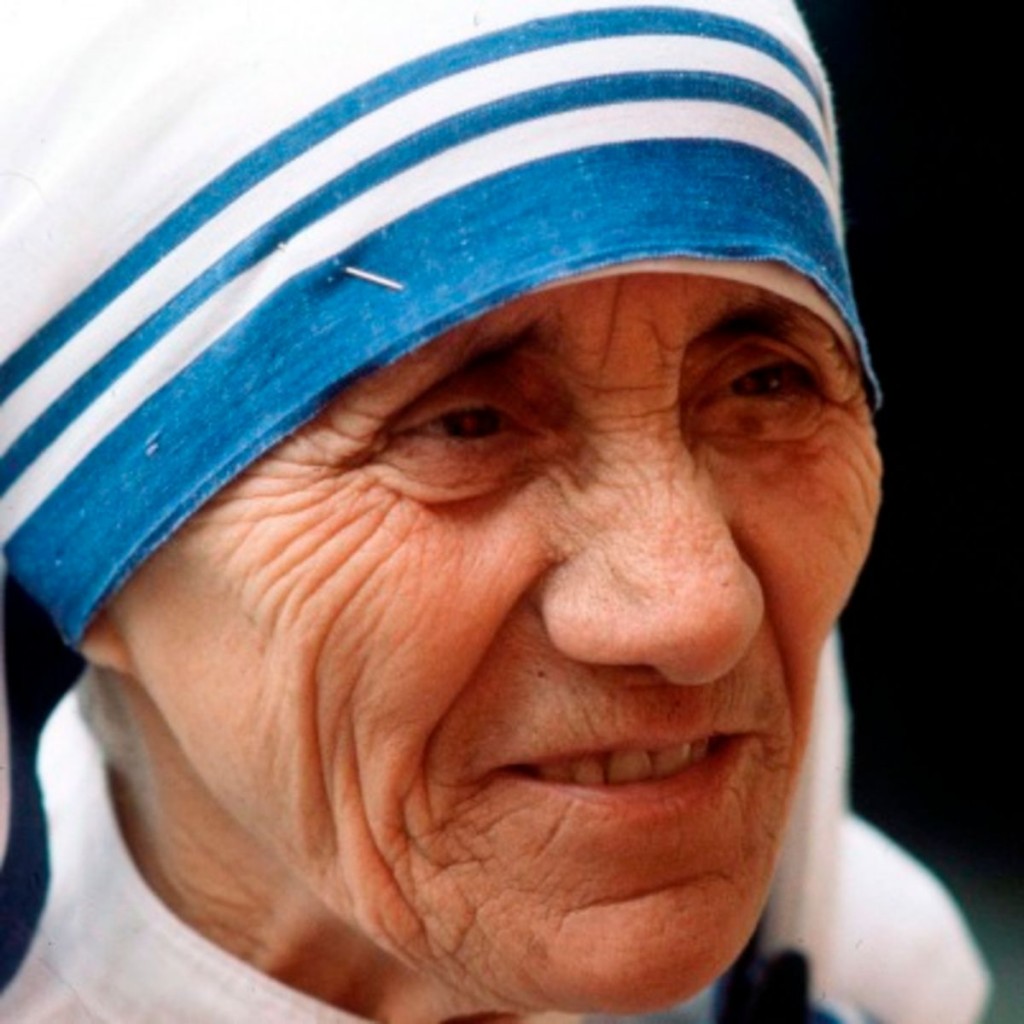By Nancy J. Schaaf
On September 4, 2016, Pope Francis canonized Mother Teresa who is now known as St. Teresa of Kolkata. This diminutive nun was known to Susan McCaffrey for many years. Susan, an avid reader about the life and work of Mother Teresa, admired this saint for her work in serving the poor. Susan, a private duty nurse living in Horsham, PA, wanted to serve the poor, too.
In 1988, Susan had an opportunity to go to India to serve the poor. Susan fervently believes that the Holy Spirit guided her journey to India. Susan relates that she felt this urge to go to India, but thought how was she, a married woman with two children, going to manage that? The Holy Spirit had definite plans for Susan. Susan said her morning devotions and asked, “Lord, do you really want me to go to India?” It was 9:10 on a weekday morning. Susan’s mail delivery had never been prior to 3:00 in the afternoon for over ten years that she lived in that house. That morning, after praying her devotions, she looked outside to see that her mail had been delivered. As she brought the mail into the house, she saw a newsletter from the Episcopal Diocese and as she flipped it open, the page showed the photos of a priest and the headline: Priest Returns from India and is Going Back.” Susan had her answer. She was expected to go to India.
This felt like a response to her prayers until she spoke with the coordinator of the trip. Susan was informed that she would need $2800 to come with his volunteer group to cover the expenses of the trip including the plane, room and board. Susan had only $5.27 in her bank account. Susan’s thoughts were filled with various ways could try to raise the money. She received an unexpected phone call from her sister-in-law who told her that she felt she felt compelled to call her and inquire as to how she was. Susan related her desire for working with the poor in India and her need to raise the money. Her generous sister- in- law insisted that she would send an $1800 check to cover expenses as she felt that if anyone should be able to go and serve, it was Susan. She told Susan that if she didn’t manage to raise the rest of the money, to let her know and she would send additional funds. Susan notified her parish priest and through his efforts, the parishioners raised the rest of the money in just over one week. She now had the money to fund her trip to India to serve the poor. The Holy Spirit according to Susan had plans for her.
In January 1988, the arrangements were finalized. Susan would be going to Kolkata; however, she was told that Mother Teresa was in England and the chances of meeting her were nil. Again, the Holy Spirit had other plans in mind. Mother Teresa wanted to spend the Epiphany with her sisters and so she flew home to India. Susan did get to meet Mother Teresa on this special feast day honoring the wise men who followed a star to find the child Jesus. Susan followed her star and found Mother Teresa and the poorest of the poor.
Susan not only met Mother Teresa but also served with her and had several conversations with the now saint. When Susan first met Mother Teresa, she recalls, “I knew I was in the presence of holiness.” Mother Teresa looked at Susan and said, “Daughter, give me your hand.” As she held Susan’s hand, she moved each finger said, “We do it for Jesus.” With these five words, she closed into a fist the five fingers of Susan’s hand. And then she said, “Daughter, you have the whole answer here in the palm of your hand.
Susan spent five weeks working at the various facilities including Kalighat, the house for the destitute and dying which Susan says was Mother Teresa’s favorite house. The volunteers literally lifted some of these people from the gutters. The work here consisted of bathing the patients, cleaning the bed linens, administrating medicines, feeding those who needed assistance, and offering comfort.
One day at the Kalighat facility, Susan began to help a woman who was in deplorable condition. This woman had been found in the streets and was dying. She was literally a skeleton covered in maggots and filth. The nurses were not able to start an IV as she was so dehydrated. Susan said, “What do I do?” One of the sisters replied,” Just be.” And so Susan held and comforted the woman. The woman looked into Susan’s eyes and said, “I thirst” and then she expelled her last breath.
Later that same day, Susan had a brief conversation with Mother Teresa. When asked if she worked today, she replied that she had. Mother Teresa asked Susan if she had seen Jesus today. Susan replied, “Yes, I saw Jesus in the eyes of the woman who died in my arms.” Mother Teresa then asked her final question, “Daughter, did Jesus speak to you today?” Susan glanced behind Mother Teresa and looked into the Chapel at the Motherhouse where she saw the crucifix and the words “I thirst. I quench.” A look of understanding came across her face and she said,” I understand. Yes, Mother, Jesus said ‘I thirst.’”
Mother Teresa has had a long meaningful association with those two words. In the Chapel a huge crucifix hangs behind the altar and these words are painted in bold black letters “I thirst.” These two words are part of the seven last words Jesus said while dying upon the cross on Good Friday and serve as a reminder of the purpose of the Missionaries of Charity that Mother Teresa founded. In her book, Where There is Love, there is God, Mother Teresa says “We have these words in every chapel of the MCs to remind us what an MC is here for: to quench the thirst of Jesus for souls, for love, for kindness, for compassion, for delicate love.”
In 1946, the Holy Spirit called her to serve the poorest of the poor. In Come Be My Light, Mother Teresa has maintained that the Missionaries of Charity were founded “to satiate the thirst of Jesus,” and she included this statement in the founding Rules for the Missionaries of Charity order: “The General End of the Missionaries of Charity is to satiate the thirst of Jesus Christ on the Cross for Love and Souls.”
One of Susan’s jobs was to help prepare food for over 2000 people who gathered daily for a meal. She recalls the nuns going into the kitchen and realizing that they had no food. All the bags were empty; there was no bread and no rice. The nuns ran back to the motherhouse to tell Mother Teresa. She pointed to two nuns and directed them to the chapel to pray. She pointed to Susan and another sister and told them to boil water. Susan said that it was less than ten minutes later that several trucks rolled up stuffed with food. Apparently, there had been an electrical outage and several restaurants donated their food rather than let it spoil. That day, they were able to feed the poor.
While working at Prem Dam, a facility for tuberculosis patients, Susan discovered a new way to wash clothes. The dirty clothes were placed into a large cistern filled with hot water. The sisters told Susan to remove her socks and shoes. She did so and then was told to get in and walk. Susan did along with the two other nuns becoming “human agitators.” She started singing, “this is the way we wash our clothes so early in the morning.” The nuns joined in. She did notice Mother Teresa standing in the doorway observing, smiling, and shaking her head in amusement. Even the smallest task was joyous service.
On another day at Prem Dam, Susan was helping the nuns change dressings and bandages. She noticed that one of the nuns tore the bandages with her teeth. Susan stopped her and proceeded to explain, how to do a sterile (as sterile as could be) dressing changes. Mother saw and asked other sisters to come in and Susan gave a lesson on sterile technique.
Susan also spent time working at the leper colony at Telegar. Susan recalls that all the linens and the nuns’ saris are made by the lepers.

Not only is the cotton grown there, but the people make the blue dye for the saris, and using wooden looms, the lepers weave the cotton into the sheets and clothing. Susan said that each nun does not own anything including clothing. Each sister has two saris; one for wearing while the other was being washed. In addition, the nuns just selected a sari from the clean clothes. None were assigned, even Mother Teresa’s. Susan was amazed that the most untouchable people in the world, the lepers, made the clothes for the most touchable people.
She knows that this experience changed her as she thinks she is a better parent, is more tolerant and is an improved listener. She says she no longer worries about material things as she is more focused on the spiritual. Mother Teresa gave Susan turquoise rosary beads with a white cross as a gift. Susan recalls going into the chapel at the motherhouse for adorations. The nuns started praying, but Susan only knew two prayers, one the Lord’s Prayer so that is what she said. Mother Teresa said, “Daughter, give me your hand.” Susan did and Mother Teresa placed these beautiful beads into her hand and said “Now, you can prayer like us.” Susan treasures these beads. As a matter of fact, when she was ordained a deacon, her bishop held these very beads.
She is now a Deacon at Grace Episcopal Church in Port Orange, FL. During her last conversation with Mother Teresa, Susan was commissioned “to tell everyone who will listen what you have seen, what you have heard and what you have done in Kolkata.” Over twenty-eight years later, the now Rev. Susan is still telling the story. Her service to others is still based on her lessons learned from St. Teresa of Kolkata.
Nancy J. Schaaf, a retired Educator and Registered Nurse, is the author of two books on her family genealogy and several article have been published in national magazines such as Woman’s World, Ft. Myers Southwest Florida Magazine, Everton’s Genealogical Helper, Family Tree, Good Old Days, and the Christian Courier.
Photo: Nancy J. Schaaf & The Rev. Susan McCaffrey, Deacon at Grace Episcopal Church Port Orange, FL

